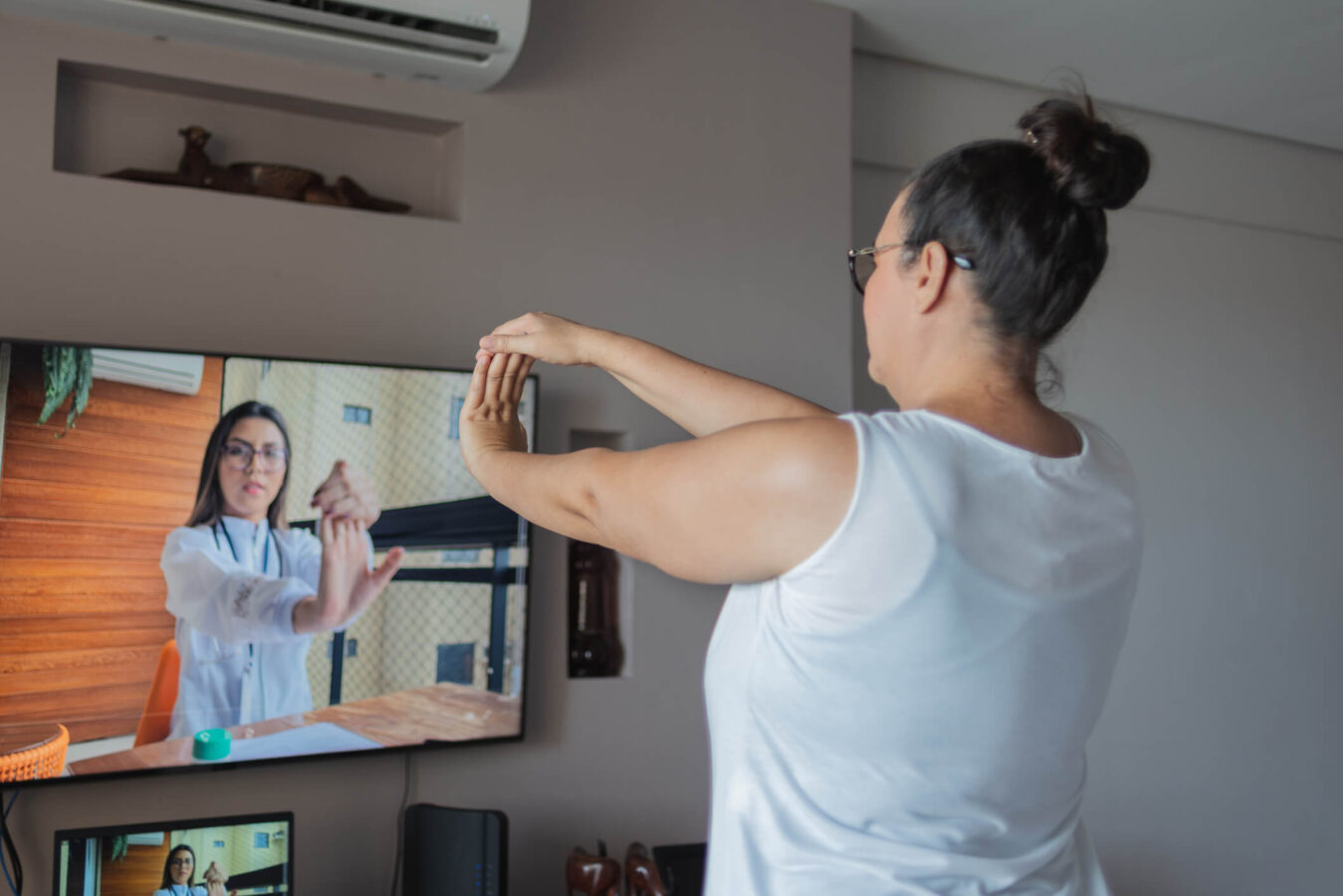
Medically reviewed by Misty Seidenburg
Are you looking for physical therapy to improve your movement and manage pain from a long-term health condition but find it challenging to make it to your local clinic for appointments? Virtual physical therapy may be the answer.
Benchmark PT clinics now offer virtual treatment to help patients with chronic pain receive expert care and support to improve their quality of life. Continue reading to learn more about this innovative treatment option.
Virtual care can be provided in many ways. A common method is through telehealth- the use of phone calls, video calls, online platforms, and other digital technologies to provide long-distance healthcare services. Virtual care is an aspect of telehealth referring to patient-provider interactions.
Although virtual healthcare existed before 2020, its use surged dramatically during the COVID-19 pandemic when in-person care was heavily restricted. According to data on virtual healthcare, 80% of respondents reported using telehealth at least once in the past year. By 2024, 114 million users indicated a preference for virtual consultations over traditional in-person appointments.
Here are some reasons to consider online physical therapy if you are living with chronic pain due to aging, illness, or injury.
For someone dealing with chronic pain when even simple tasks can be a challenge, the idea of getting dressed and going to the nearest clinic can feel daunting, causing some to forgo treatment altogether.
But with telehealth physical therapy, you can see your physical therapist from the comfort of your own home. Plus, there’s no need to carve out extra time in your schedule to travel to and from appointments, which is also good news for caregivers, parents, and anyone without access to transportation.
Private virtual physical therapy sessions offer one-on-one, real-time interaction with a licensed physical therapist, similar to in-person appointments. However, with telehealth, an added benefit is that the therapist can observe how the patient moves within their home environment.
This allows the therapist to provide tailored recommendations and guidance on adjustments that can help improve movement efficiency, enhance safety, and reduce the risk of falls and other common hazards.
Virtual physical therapy sessions provide more flexibility for both patients and providers. They can often be scheduled outside of regular clinic hours, making it easier to find a time that fits your schedule. With more appointment options, you are less likely to miss sessions, helping maintain your progress and momentum.
Individuals with chronic pain may experience changes in coordination, balance, and muscle strength, which can increase their risk of injury. Participating in physical therapy in a safe and familiar space can help lower the risk of accidents. Virtual visits also reduce exposure to germs and illnesses, which is especially important for individuals with compromised immune systems.
Performing physical therapy in a familiar environment can provide a sense of comfort and ease for patients dealing with long-term challenges. Patients who are actively engaged and feel optimistic about their health and wellness journey tend to be more motivated to put in greater effort. They communicate more effectively with their healthcare providers and are more likely to follow treatment plans and stick to prescribed exercises, often resulting in better overall outcomes.
Participating in virtual care doesn’t require any special training or equipment. All you need is a reliable internet connection and a device with a microphone and camera. If you’re new to telehealth physical therapy, here’s a brief overview of the process.
Physical therapy starts with an initial consultation, where your therapist will discuss your chronic pain symptoms, medical history, and treatment goals. An in-person physical exam may be required to assess the location and cause of your pain and how it’s affected by different movements, so follow your therapist’s guidance. During this evaluation, your therapist may ask you to perform specific exercises or movements to observe your form and body mechanics.
Based on this evaluation, your physical therapist creates a personalized program of stretches, exercises, and other techniques to manage chronic pain and improve function and movement. Patients with chronic pain may benefit from hands-on manual therapies, so for this reason, some in-person sessions may be recommended.
Now, it’s time to dive into virtual physical therapy. This program consists of scheduled remote appointments, during which the physical therapist guides you through therapeutic movements and monitors your progress. They provide real-time feedback, including modifications and corrections to help relieve your pain and make tasks less challenging.
Your physical therapist may also assign a home exercise program (HEP) for you to complete independently between virtual appointments. Think of your HEP as “homework” to help you build strength and flexibility between sessions. Your HEP enables you to stay motivated and engaged, allowing you to maintain consistent progress and achieve better results.
Your physical therapist can monitor your progress via phone or video. During these virtual check-ins, you can discuss your symptoms and concerns and ask questions. At regular intervals, your therapist will review your treatment plan and make adjustments as needed to ensure it is aligned with your chronic pain treatment goals.
Before each session, it’s a good idea to check your Wi-Fi connection, clear a safe space for movement, and gather any necessary equipment. This ensures you can fully focus and maximize your time with your physical therapist.
Also, as noted above, while virtual physical therapy offers increased accessibility and convenience, it may not be suitable for everyone or every appointment. Physical therapy is tailored to each individual, and your therapist may recommend a hybrid approach that combines in-person and virtual sessions to help you achieve your treatment objectives.
Staying consistent with physical therapy is key to managing chronic pain, and virtual sessions can help you stay on track. The convenience of virtual appointments makes it easier to stick to a routine and avoid setbacks, and you’re more likely to follow through with treatment when it’s flexible and accessible. Find a physical therapy clinic near you or request an appointment today!

